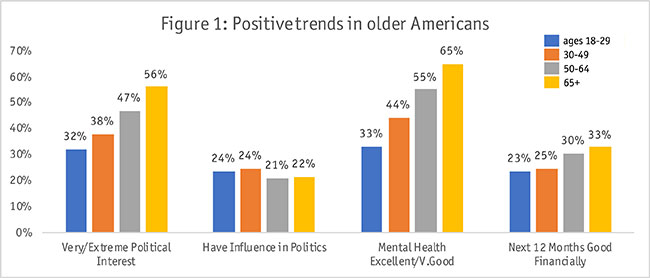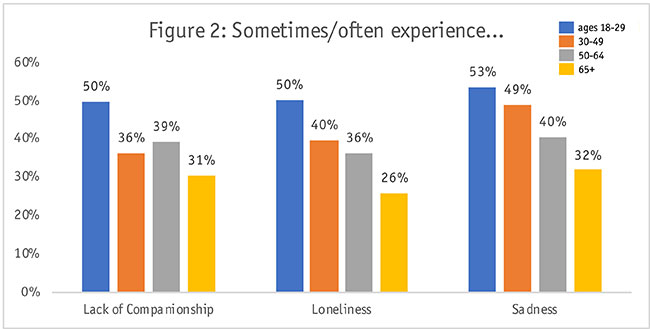Updating the narrative
Editor's note: David Dutwin is senior vice president, chief scientist at NORC at the University of Chicago, AmeriSpeak. He can be reached at dutwin-david@norc.org.
The COVID-19 pandemic has been one of the greatest health challenges in most people’s lifetimes. It has put Americans under tremendous stress: Anxiety about getting the disease has been significant, especially with the more deadly early strains, particularly for anyone over age 50, and more so for those with a comorbidity. There has been economic stress too: The economy plunged, the market became more volatile and no one knew what the future would hold. Every time it seemed we had gotten past the disease, a new variant would arise.
Perhaps the worst of all has been the impact of the disease on mental health. People had to “shelter in place” for, in many cases, over a year. While the impact of concern about isolation typically focused on school-age children and their lack of in-person schooling and socializing, the strain on mental health spanned all age groups and perhaps hit older Americans just as much as anyone.
As an over-50 single dad, I became completely isolated in my home when my kids were not there. Sure, frequent Zoom calls with work colleagues and business partners offered some social contact but we all discovered that videoconferencing was just not the same as connecting face-to-face. Worse still was my 89-year-old father’s situation: His assisted-living center did everything they could to “wall off” from the disease and as a result, I was unable to see him in-person for many months. He was isolated from the only family he had left and unable to even have his meals in the dining hall of the facility. He, in effect, lived in a single room for eight straight months. The mental health toll on the many such adults in similar situations in retirement communities was palpable.
All but ignored
Reports and surveys on older Americans even in non-pandemic times often paint a less than rosy picture. Financially, the story of older Americans has been one of decline. Surveys have reported financial anxiety among older Americans for generations and with historically declining earning potential, marketers in the 20th century all but ignored this age cohort in pursuit of younger ones that simply spent far more than older Americans. Additionally, the common political narrative of older Americans has been that while they are more involved than younger Americans by virtue of their rate of voter registration, voting frequency and volunteering frequency, they are also, somewhat paradoxically, more skeptical, critical – pessimistic even – about politics and what the future holds. Finally, self-reported health of course declines with age and the frequency of maladies increases. These and many other declines in self-reported health and wellness are well documented.
However, this story is not just incomplete, it has also failed to keep up with the reality of the changing times. And in response to the pandemic, the narrative is simply off base. The story of older Americans is, in fact, not one of complete financial pessimism, of low earnings and spending, or of political cynicism. Communal isolation thanks to COVID-19 has not quite produced the negative impact on older Americans as we might have expected. Rather, research findings from Foresight 50+ by AARP and NORC and NORC’s AmeriSpeak Panel, both scientifically valid research panels built from random samples and in-person recruiting, combined with other data, paint a vastly different picture of Americans aged 50 and older (Figure 1).

First, Americans 50 and older, without much fanfare, recently passed a significant economic milestone: Over half of all consumer spending in the U.S. is now thanks to this age cohort. Moreover, persons age 65+ are now the most affluent of any age category: From 1989 to 2016, their net worth went from approximately $150,000 to $250,000. Health does indeed decline with age but not in the same way and with the same effect as it did even 25 years ago. Most persons over age 80 continue, for example, to live in their own homes, which for the vast majority have appreciated considerably in the past two decades, adding significantly to their net worth. And, combined with the fact that sometime around a decade or so from now over half of all U.S. adults will be over age 50, the purchasing power of these Americans has yet to even realize its full potential.
Second, political interest among older Americans has, if anything, increased in the past few decades, with now over half of them reporting they are very, or even extremely, interested in politics. They are now generally no more likely to claim they have no power in politics than other age groups; they in fact hold the same level of their own political self-efficacy as do younger generations, even those under age 30 who are commonly understood to be within the age of advocacy, the age of political action. Indeed, in 2018, typical of other midterm elections, persons ages 65 and older voted at nearly 70 percent the frequency of those age 18-29 (81% versus 49%). Though less pronounced, the gap in presidential elections is still nevertheless considerable.
Third, and perhaps most notable, is how older Americans have fared during the pandemic. Of course, while many, in all age categories, have struggled with mental health before and during the past few years, older Americans have stayed resilient and held onto optimism, by far more than any other age group. They leaned on friendships and family; they had the tools, the experience and history to hold steady and they took a decidedly positive view. We found that yes, while there is a linear negative trend in overall health by age group, there is actually quite the opposite trend for mental health. Levels of isolation, loneliness and sadness, as just a few examples in our data, are significantly lower among those 50 and older and especially 65 and older, when compared to younger generations (Figure 2). “We will get through this” seems to be a driving message among this age group.
Standing the test of time
Historically, the story that the data has told us of older Americans was one of failing health, loneliness and isolation and financial hardship and instability. However, our research has showed us that it is time to write a new narrative. Older Americans are both dynamic and resilient and, based on our data, are standing the test of time and circumstance better than most of us had ever thought possible. As someone just a few years into the age 50+ group, I could not agree more about the need for a shift in tone in the conversation. The trends in the data tell a different tale of how older Americans are living and, further, thriving, in today’s social, political and economic landscape. Now it is time for us to make sure that reality is reflected in the way it deserves. I, and I am sure many other Americans aged 50+, will be pleased to see the change in perception.

